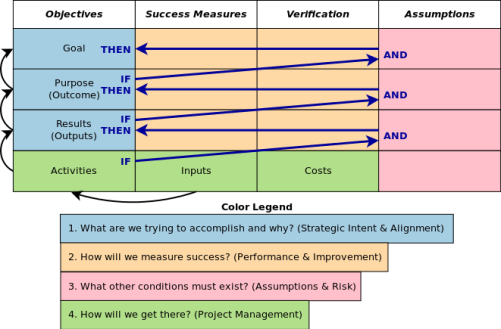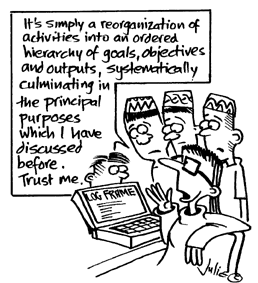A ‘Logical Framework Approach’ is usually used in consultancy projects to give them coherence across the ‘horizontal’ and ‘vertical’ aspects of the problem at hand. So what is ‘horizontal logic’? It’s kind of what it says in the title really, a logical progression across a horizontal platform. So this could be picking up on the horizontal progression of your slides, to the structure of your research in search of the answer to a particular question. And ‘vertical logic’ is following upwards across the hierarchy of priorities you are trying to address.
This can be put into a ‘Logical Framework Matrix’ or ‘LogFrame’ like the one below
The cartoon gets it pretty right in terms of the simple idea of the LogFrame approach. Check out the full blog post here and see how strategic project management can work better if using this structure. http://medepi.com/2013/01/29/logframe/
For more general uses of horizontal and vertical logic, take a look at the following websites…
http://www.slideshare.net/pcomo/business-olympics-power-point-instructions-2483961 A simple slideshare presentation here on making good presentations that conform to horizontal and vertical logic. When presenting your research findings and solutions to the client, it is important to ensure that they are understanding what you are saying. The audience may be comprised of top CEOs and stakeholders, or might be a broad range of workers from across the company. Regardless, using horizontal logic in your presentations will ensure that the key points will be retained by the audience and taken away to reflect on.
http://www.docstoc.com/docs/36976564/An-Outline-of-The-Logical-Framework-Approach For a more thorough guide through the Logical Framework Approach, check out this 34 slide document (which you can also download). Includes plenty of diagrams.
http://www.migration4development.org/content/how-complete-logframe A good step by step guide to ensuring you fulfil the LogFrame. This help sheet can also be downloaded in pdf format at the bottom of the page.
http://lgausa.com/logframe_approach.htm A more complicated diagram but the article is succinct in explaining that the LogFrame stage is important in ensuring your whole team knows what they are trying to achieve.
http://www.mpug.com/articles/simple-powerful-proven-logical-framework-approach/ This is an overview of Chapter 16 in the book ‘The Fast Forward MBA in Project Management’ and explains the IF and THEN arrows well that are shown in the graphic above. Includes a basic table template to work from.
Terry Schmidt also explains this with a thorough example in the following Youtube tutorial:
http://www.hedon.info/docs/logical_framework-CentreForInternationalDevelopmentAndTraining.pdf This is a pdf document created by the University of Wolverhampton showing how to create a Logical Framework Approach. Includes a summary of the pros and cons of using this for a project.
http://www.evropa.gov.rs/Evropa/ShowDocument.aspx?Type=Home&Id=525 This is an interesting document which may be useful to browse through – made by the Government of Serbia, it explains how the Logical Framework Approach can be used to answer governmental questions. It is meant as a user guide to the project management cycle even though the topics covered may be slightly out of the business consultant’s field.
http://www.intrac.org/data/files/resources/518/The-Use-and-Abuse-of-the-Logical-Framework-Approach.pdf Similarly to the document above, this is a based on NGOs using an LFA platform to ensure projects are carried out well and to prove to stakeholders and donors that objectives are being achieved. However, the report shows that there are aspects of the LFA framework that have drawbacks.

